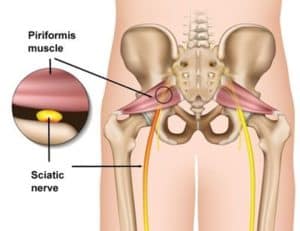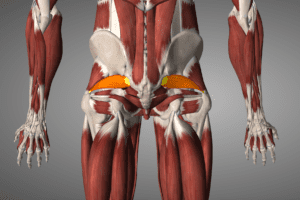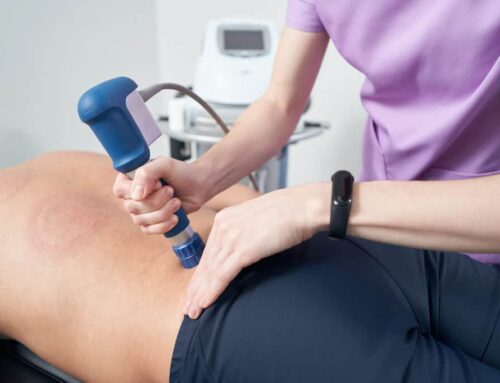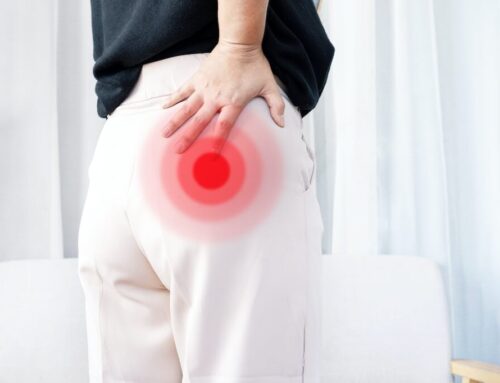
Piriformis syndrome is a condition in which the piriformis muscle, which is located in the back of your hip, goes into spasm. This can cause either buttock or hip pain. It can also compress the sciatic nerve and cause pain, tingling, and numbness down the back of your leg, or into the foot.
Piriformis syndrome can sitting or standing to be uncomfortable. It can also limit your ability to squat, run, hike, or do household chores. Often it can disrupt your sleep, making it hard to find a comfortable position and giving you hip pain at night. This can be frustrating to manage, because there are so many different treatment approaches. A quick internet search will leave anyone confused about whether they should do ice, heat, massage, stretch, injections, medications…the list goes on. First, you must find the root cause that caused the piriformis to go into spasm in the first place if you want to fix the pain.
What is the piriformis?
The piriformis is a muscle that attaches your hip bone to your tailbone/pelvis area. It runs from the outside of your hip, to the front of the bone called your sacrum.

Most of the time, your sciatic nerve runs underneath the piriformis. Sometimes the nerve runs through the piriformis. This means that when your piriformis goes into spasm, it can pinch the sciatic nerve and lead to pins and needle and pain in the leg.
Its main job is to help stabilize your hip. When it goes into spasm, there’s always a reason.
What causes muscles to spasm?
There are just a few causes of muscle spasms and tightness leading to piriformis syndrome.
- Injury
- Joint instability
- Muscular Weakness
Let’s take a look at each of these.
Injury
Muscles have a reflex that causes them to tighten when an area of the body is injured. It’s the way that we protect ourselves. The muscles tighten to form a splint, and protect the surrounding area.
Joint Instability
There are two types of structures that create ‘stability’ in your body. Good stability means that your ‘passive structures’ and ‘active structures’ work well together to help you stay upright. ‘Passive structures’ include joints and ligaments. ‘Active structures’ are the muscles. Try standing on one leg. How stable are you? Is one side more stable than the other? Are you leaning to one side? Flapping your arms? If so, chances are you are less stable than you could be.
Muscular Weakness
The piriformis can also spasm due to muscular weakness. Muscles LOVE to compensate for other muscles that are not doing their job. This happens a LOT with the piriformis. So when small muscles closer to your hip do not work properly, the piriformis picks up the load. The muscles typically at fault for this are complicated to pronounce and spell. Ready for it?
- Obterator Internus
- Obterator Externus
- Gemellus Superior
- Gemellus Interior
When these muscles don’t fire appropriately, the piriformis does their work for them. Over time, this leads to your piriformis being exhausted, achey, and overworked.
How Is Piriformis Syndrome Solved?
Many of the treatments for piriformis syndrome focus on the wrong thing. They focus just on the piriformis and the sciatic nerve. This leads down the road of injections, TENS units, ice, heat, stretching, and massage.
Have you already tried these things?
If you have tried these things and they only result in temporary relief, that’s good, because you already know what does not work for long term relief.
So if you want a long term solution to piriformis syndrome, then you must address the root cause. The root cause is most likely one of the 3 things we just discussed. If you have experienced an injury, then it’s likely that joint instability and muscular weakness have resulted from it. That means that fixing the joint instability and correcting the muscle weakness is the only way to solve your piriformis syndrome.
Have You Already Tried This?
Many people have tried doing some form of exercises for their piriformis syndrome. The problem is that they have a hard time keeping their piriformis from compensating. Training the body to isolate the right muscles is the most important part of correcting piriformis syndrome for good.
Once you’re able to activate the right muscles with the right movements, the piriformis can begin to take a break. As you get the hang of it, we start to see relief from gnawing glute pain and any nerve pain and sciatica. At that point, it’s essential to strengthen all of those hard to pronounce muscles so that it doesn’t happen again!
Isolating those muscles is tough business, and something you need a specialist help with. The positioning needed to perform the exercises can vary from person to person depending on how you compensate. If you think you have piriformis syndrome, want to address the root cause, and get rid of your pain for good, click the orange button below and ask about our Discovery Visit. If you qualify, we will give you a complimentary a no-obligation consultation to help you figure out the root cause of your piriformis syndrome and how to fix it.
Image credit:
- Image 1: Essential Anatomy
- Image 2: https://redefinehealthcare.com/piriformis-syndrome/
How Can Working With An Expert at DPT Help You Fix Your Piriformis Syndrome?
- Your treatment plan is tailored to your lifestyle to get you to be able to do the things that are most important to you.
- You will learn about the body, the muscles, and how everything is connected.
- You will understand how to take care of yourself so you can continue to enjoy being pain free and active well into the future.
- You’ll learn everything that’s contributing to your piriformis syndrome, and have a plan to get it corrected.
- Your DPT team understands where you are at, and designs a plan to help you get to where you want to be in as few, or as many steps as it may take.
Click the orange button to apply for your visit now.
Piriformis syndrome is a condition in which the piriformis muscle which is located in the back of your hip, goes into spasm. This can cause either buttock pain, or it can compress the sciatic nerve and cause pain, tingling, and numbness down the back of your leg, and sometimes into the foot.
It can be uncomfortable to sit or stand for long periods of time with piriformis syndrome. It can also limit your ability to squat, run, hike, or do household chores. Often it can disrupt your sleep, making it hard to find a comfortable position and giving you hip pain at night.It can be frustrating to manage, because there are so many different treatment approaches. A quick internet search will leave anyone confused about whether they should do ice, heat, massage, stretch, injections, medications…the list goes on. To know which treatment will give you a long lasting solution, you have to find the root cause for the piriformis to spasm in the first place.
What is the piriformis?
The piriformis is a muscle that attaches your hip bone to your tailbone/pelvis area. It runs from the outside of your hip, to the front of the bone called your sacrum.

https://redefinehealthcare.com/piriformis-syndrome/
Most of the time, your sciatic nerve runs underneath the piriformis. Sometimes the nerve runs through the piriformis. This means that when your piriformis goes into spasm, it can pinch the sciatic nerve, and lead to pins and needles, and pain in the leg.
It’s main job is to help stabilize your hip. When it goes into spasm, there’s always a reason.
What causes muscles to spasm?
There are just a few causes of muscle spasms and tightness leading to piriformis syndrome.
- Injury
- Joint instability
- Muscular Weakness
Let’s take a look at each of these.
Injury: Muscles have a reflex that causes them to tighten when an area of the body is injured. It’s the way that we protect ourselves. The muscles tighten to form a splint, and protect the surrounding area.
Joint Instability: There are two types of structures that create ‘stability’ in your body. Having good stability means that your ‘passive structures’ and ‘active structures’ work well together to help you stay upright. ‘Passive structures’ include joints and ligaments. ‘Active structures’ are the muscles. Try standing on one leg. How stable are you? Is one side more stable than the other? Are you leaning to one side? Flapping your arms? If so, chances are you are less stable than you could be.
Muscular Weakness: The other reason for the piriformis to spasm is due to muscular weakness. Muscles LOVE to compensate for other muscles that are not doing their job. This happens a LOT with the piriformis. When small muscles right next to your hip do not work properly, the piriformis picks up the load. The muscles typically at fault for this are complicated to pronounce and spell. Ready for it?
- Obterator Internus
- Obterator Externus
- Gemellus Superior
- Gemellus Interior
When these muscles don’t fire appropriately the piriformis does their work for them. Over time, this leads to your piriformis being exhausted, achey, and overworked.
How Is Piriformis Syndrome Solved?
Most of the treatments for piriformis syndrome focus on the wrong thing. They focus just on the piriformis and the sciatic nerve. This leads down the road of injections, TENS units, ice, heat, stretching, and massage.
Have you already tried these things?
If you have tried these things and they only result in temporary relief, that’s good, because you already know what does not work.
If you want a long term solution to piriformis syndrome you must address the root cause. The root cause is most likely one of the 3 things we just discussed. If you have had an injury, then it’s likely that joint instability and muscular weakness have resulted from it. That means that the only way to solve your piriformis syndrome is to fix the joint instability and correct the muscle weakness.
Have You Already Tried This?
Many people have tried doing some form of exercises for their piriformis syndrome. The problem is that they have a hard time keeping their piriformis from compensating. Being able to isolate the right muscles is the most important part of correcting piriformis syndrome for good.
Once you’re able to activate the right muscles with the right movements, the piriformis can begin to take a break. As you get the hang of it, you’ll experience relief from gnawing glute pain and any nerve pains and sciatica. At that point it’s essential to strengthen all of those hard to pronounce muscles so that it doesn’t happen again!
Isolating those muscles is tough business, and something you need specialist help with. The positioning needed to perform the exercises can vary from person to person depending on how you compensate. If you think you have piriformis syndrome, and want to address the root cause and get rid of your pain for good, I suggest you click the orange button below and ask about our Discovery Visit. If you qualify, we will give you a complimentary ‘Discovery Visit’, it’s our no-obligation consultation, where we can help you figure out the root cause of your piriformis syndrome, and how it can be fixed.
How Can Working With An Expert at The Doctors of Physical Therapy Help You Fix Your Piriformis Syndrome?
- Your treatment plan is tailored to your lifestyle to get you to be able to do the things that are most important to you.
- You’ll learn about the body, the muscles, and how everything is connected.
- You’ll understand how to take care of yourself so you can continue to enjoy being pain free and active well into the future.
- You’ll understand everything that’s contributing to your piriformis syndrome, and have a plan to get it corrected.
- Your DPT team understands where you are at, and designs a plan to help you get to where you want to be in as few, or as many steps as it may take.
Click the orange button to apply for your visit now.




